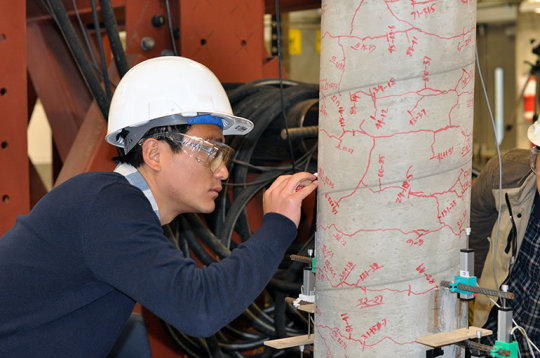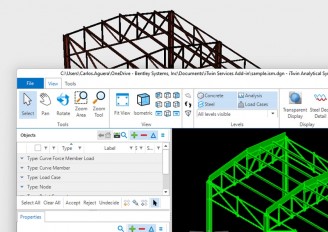Bridges built to meet current Canadian safety codes are being 'overbuilt' while still prompt to taking high structural damage after a major earthquake

Researchers at the University of British Columbia (Okanagan campus) examined a variety of bridge types along with design requirements under the Canadian Highway Bridge Design Code. As part of the research, the seismic performance of shape memory alloy reinforced and post-tensioned bridge piers have been tested in the University’s Applied Laboratory for Advanced Materials and Structures (ALAMS). The results, published in the Journal of Structural Engineering, ASCE, point out that bridges are being built to withstand the force of an earthquake, however they are being overbuilt, resulting to unnecessary construction expenses.
When designing a bridge, engineers calculate the strains the material can withstand, but they must also make calculations for the probable post-earthquake functionality of the structure. UBC professor Shahria Alam states that "We've determined it's very unnecessary to design a structure with that much reinforcement. The code calls for a lot of material and the size of the columns and beams are simply too large." According to the professor, the up-to-now common technique of adding more steel reinforcement to make structures stronger now seems false, and the Canadian Highway Bridge Design Code may eventually be revised. “Public safety is the most important aspect and we have to build structures so they do not collapse during an earthquake,” he continues. “What we’re saying now is that we should be building structures that not only save lives, but we should also be saving the structure itself.” Alam and his team have proposed target residual drift-based criteria for performance-based seismic design of bridges that have self-centering capability, in order for the engineers to be able to build almost damage-free bridges even after a major earthquake.

Student Peng Zhang traces cracks in the column during a strength test in UBC Okanagan’s Applied Laboratory for Advanced Materials and Structures. (Image courtesy of University of British Columbia Okanagan campus)

Test leader Mosharef Hossain, right, along with fellow UBC engineering student Rashedul Kabir, left, carefully inspect a concrete column after it has been put through a lengthy shake test at UBC Okanagan’s Applied Laboratory for Advanced Materials and Structures. (Image courtesy of University of British Columbia Okanagan campus)
Source: UBC Okanagan News
Want to read more like this story?
Earthquake Engineering
Jan, 01, 2019 | EducationEarthquake engineering is a critical field of civil engineering that focuses on the analysis, desi...
Bridge Design
Jan, 01, 2019 | EducationBridge design is the process that involves the conceptualization, the strategic planning, and the...

Bridges
Jan, 01, 2019 | EducationA bridge is the structure that allows the transition from one position (A) to another (B). The a...

Types of bridges
Jun, 01, 2023 | EducationArch Bridge An arch bridge is a type of bridge that uses a curved, semi-circular structure, kno...

How advanced finite element analysis can prepare buildings for extreme events
Nov, 14, 2024 | NewsWhile most structural analysis software can evaluate everyday stresses, they often fail to prepare...

OpenBridge Designer
Aug, 28, 2023 | Software
An engineering point of view for the Tacoma Narrows Bridge collapse
Apr, 04, 2023 | EducationIntroduction An iconic civil structure is a bridge. The desire for humans to go from place to...

New design to make bridge spans longer
Sep, 27, 2018 | NewsLonger bridge spans will be achieved in the future by the utilization of new bridge forms. Resear...

Researchers in New Zealand develop a new 'rocking' technology for earthquake-resilient bridges
Jul, 08, 2021 | NewsA new “rocking” technology that could make bridges more resilient to earthquakes has been developed...
Trending

Spectacular interchanges around the world

New Release - STAAD.Pro 2024 - 2

ADINA 2025 for Structural WorkSuite

ADINA 2025 New Release!

Concrete Buildings as Rechargeable Batteries

Powerful earthquake shakes central Philippines, dozens killed


